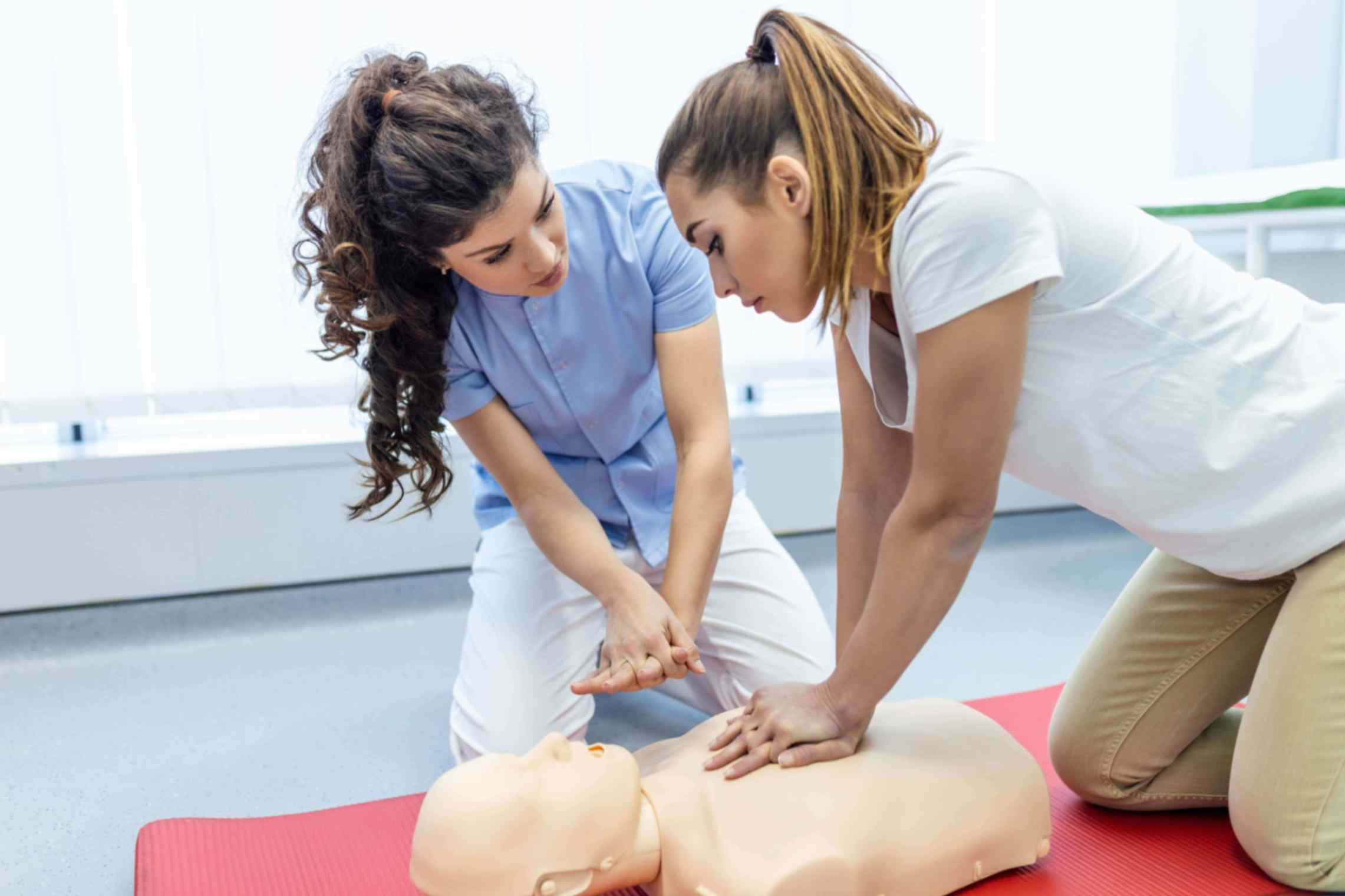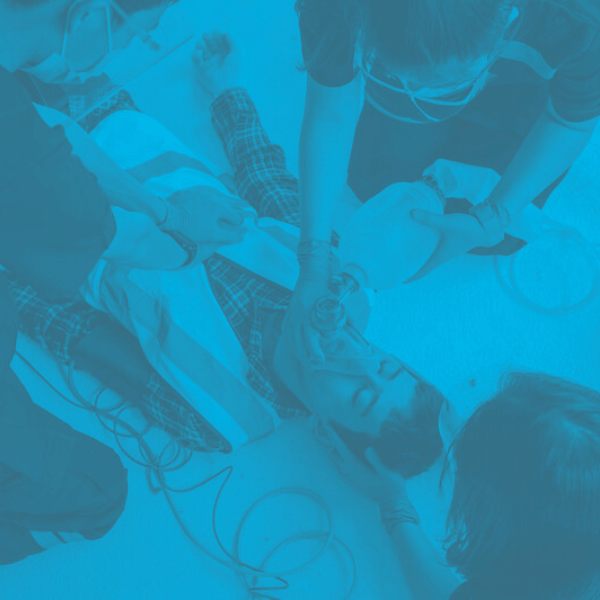What are the 7 Steps of CPR?
What are the 7 Steps of CPR?

by Greta Kviklyte
Life Saver, AMC
Co-authored by Kim Murray, RN, M.S.
posted on Jul 23, 2024, at 5:15 am
Imagine you’re at a crowded event, enjoying the day, when suddenly someone collapses. Your heart races. Someone must act fast. Then you realize you’re that someone—a rescuer who is trained in CPR and First Aid.
You know exactly what to do because you learned CPR and First Aid through an accredited online certification program from Advanced Medical Certification. But did you know a more advanced level of learning exists? You can learn about it in a BLS course. Today, I’ll share the answer to: What are the 7 steps of CPR? Plus, we’ll compare BLS vs CPR training to discover why you’ll want to learn these more advanced skills.
Spoiler: If you love teamwork, you’ll want to learn BLS.
We offer Online CPR and BLS Certification
CPR vs BLS
First, look at the key differences between BLS and CPR.
What is a CPR Course?
A CPR course focuses on the “Chain of Survival” initiated by bystander rescuers. This involves performing high-quality CPR to keep blood pumping to the brain during cardiac arrest until emergency professionals arrive.
You can think of the CPR you learn in the CPR course as a simplified version for everyone.
According to a review by ILCOR (International Liaison Committee on Resuscitation), even children as young as 10 could perform effective CPR and potentially save lives.
In a CPR course from Advanced Medical Certification, you learn CPR and First Aid for 25 conditions, and how to use an Automated External Defibrillator (AED). Every CPR course should cover everything you need to know about CPR for adults, children, and infants.
What is a BLS Course?
A Basic Life Support (BLS) course covers CPR, AED plus more advanced team-oriented and medical skills. It is a comprehensive emergency response protocol, primarily for healthcare providers, such as:
- Doctors
- Nurses
- Medical Assistants
- EMTs
You can take a BLS course to go through each step and decision in detail. As you learn the BLS algorithm and how to perform the steps competently, you’ll feel more confident you can handle an emergency.
What Are the 7 Steps of CPR?
1. Assess the Scene
Ensure that the scene is safe for you and the person who needs CPR. Do not put your life at risk to perform CPR.
2. Tap the Person
Tap on the person and speak loudly, “are you okay?”.
If the person can respond verbally or through movement, they don’t need CPR, but they may still need first aid or more advanced medical care.
3. Get Help
Call for help if you’re alone with the person. If you don’t see anyone, yell for someone to call 911.
If you do see someone, look directly at them and clearly say, “Call 911”.
**Eye contact is critical because of the well-documented Bystander Effect. In emergencies, most people expect someone else to call 911. This can lead to no one calling.**
Also, call for an AED machine, even if you are unsure if one is available.
If you are alone and no one comes to help, you should call 911, quickly tell them what the emergency is and where you are, and then stay on the line. However, you should set the phone down to provide high-quality CPR. is is critical because the out-of-hospital CPR success rate is only about 10% (TheLancet.com). However, that success rate increases significantly with high-quality CPR that begins within three to five minutes.
The person needs your full attention now.
If the person responded in step 2, you’re not doing CPR. You should instead provide first aid until emergency services arrive or the person can care for themselves. On the Advanced Medical Certifications website, you can learn first aid for many common emergencies, from frostbite to seizures to low blood sugar.
4. Check Breathing
Place the person on their back and lean down until your ear is close to their nose and mouth. Can you hear their breath? Can you feel it on your cheek? Do you see the person’s chest rising and falling?
If you detect breathing, they do not need CPR.
5. Start CPR (if Appropriate)
This step of CPR includes deciding whether to start CPR and how you will do it. Remember that once you decide to start CPR, you continue CPR uninterrupted until emergency services arrive. If another bystander knows CPR, you will alternate to keep up your strength.
According to DC.gov, EMS departments aim to arrive within five minutes 90% of the time. However, factors like city vs. rural, difficult terrain, and call volume can cause times to vary.
If you begin CPR and an AED arrives, stop, attach the pads, follow the instructions. Perform CPR while waiting for AED to alert you that it’s ready to shock.
6. Deliver Compressions
High-quality compressions at the appropriate depth are critical to the success rate.
A high-quality compression on an adult is performed at 2 to 2.4 inches (5 to 6 cm) deep. You let the chest rise between each compression as you will perform 30 compressions at 100 to 120 per minute.
To keep time, you can sing a song in your head that has this beat. Some popular CPR songs you may know include:
- Eye of a Tiger (Survivor)
- Stayin’ Alive (The Beegees)
- Everybody (Backstreet’s Back) (Backstreet Boys)
- Numb (Linkin Park)
- Gettin’ Jiggy with It (Will Smith)
- Work It (Missy Elliot)
- Sweet Home Alabama (Lynard Skynard)
- Crazy in Love (Beyonce & Jay Z)
There are many more. If you don’t know any of these songs, I found this Spotify list with almost 70 CPR songs in different genres you can check out.
7. Give Breaths
If you are the only rescuer, stop compressions long enough to clear the airways and provide two breaths. If there are two rescuers, one should provide breaths while the other pauses compressions for that time.
If you have chosen to give breaths, it’s also vital that you know how to do it correctly, and this has its own set of 7 steps:
- Use protective gear if you have it.
- Put your hand on the forehead.
- Place your fingers on the bony part of the chin and lift it gently.
- Pinch the person’s nose.
- Put your mouth around the person’s open mouth.
- Breathe deeply for one second. You should see their chest rise.
- Repeat one time more and then return to compressions.
If the person starts responding at any time, stop CPR and assess the situation.
What Are the 7 Steps of CPR for a Child?
There are some key differences between adult CPR versus child CPR.
- Assess the scene
- Tap the child and yell “are you okay?”
- Yell for help as you would in adult CPR. But if no one is available, do not stop to call 911. You prioritize starting CPR compressions over calling 911 yourself. You can use an AED on a child, so call out to see if one is available. Follow the AED instructions.
- Check the breathing.
- If no response, no breathing, or just gasping, start compressions. You perform CPR for around two minutes. This starts with 30 compressions. The compression depth for children is up to 2 inches (5 cm), depending on the child’s size.
- Perform 2 rescue breaths.
- After that, you call 911 and then resume compressions and breaths.
For CPR, a child is someone you estimate to be 12 or younger. Follow adult CPR for someone over 12.
The primary reason you start CPR before calling 911 with a child comes down to the fact that CPR’s success rate is higher in children, with one study showing it has risen from 7% to 20% out-of-hospital over the past 30 years. At the same time, the timing of CPR initiation in children has gone from 14 minutes to two minutes. This shortening of initiation time is credited for increasing these children’s survival rates, leading to this recommendation.
What Are the 7 Steps of CPR for an Infant?
An infant is a child that is under one year old. Infant CPR is like child CPR, except for the fact that you should not use your palm for compressions on an infant. Use two fingers instead.
What is the CPR Algorithm?
The CPR algorithm is an evidence-based decision tree that guides you through the above steps in a decision tree. It’s visual, making it easy to remember and follow the steps. Every potential rescuer should familiarize themselves with the CPR algorithm.
What is the BLS Algorithm?
The BLS algorithm walks medical professionals through the more advanced sets of decisions they need to make during an emergency event and provides different instructions based on whether they are alone or have a partner.
It’s also based on the latest evidence-based best practices established by the respected authority on the matter: ILCOR (International Liaison Committee on Resuscitation).
We have designed these BLS algorithms to inform both single rescuers and teams of two or more rescuers on how to deliver high-quality CPR and AED use for early defibrillation for potential adult or pediatric cases:
Pediatric BLS Algorithm
The Pediatric BLS Algorithm focuses on the unique needs of children during resuscitation. This algorithm includes steps such as assessing the scene for safety, checking for responsiveness, and activating the emergency response system.
It emphasizes the importance of performing high-quality chest compressions and providing appropriate ventilation tailored to the pediatric population. Early use of an AED with pediatric settings is also highlighted to improve survival rates in young patients. For more details, view the Pediatric BLS Algorithm.
Adult Basic Life Support (BLS) Algorithm
The Adult Basic Life Support (BLS) Algorithm outlines a systematic approach to adult resuscitation. It includes initial steps such as ensuring scene safety, checking for responsiveness, and activating the emergency response system while retrieving an AED.
The algorithm then guides rescuers to check for normal breathing and a pulse, initiating high-quality chest compressions at a rate of 100-120 compressions per minute and a depth of at least 2 inches if no pulse is detected. Rescue breaths are provided in a 30:2 ratio. The use of an AED is recommended as soon as it is available.
Basic Life Support (BLS) for Adults
The Basic Life Support (BLS) for Adults Algorithm builds upon the previous guidelines with enhanced measures to ensure high-quality care. It maintains the emphasis on early CPR and defibrillation, while adding refinements such as minimizing interruptions in chest compressions, ensuring full chest recoil between compressions, and avoiding excessive ventilation.
The updated guidelines also advocate for the use of feedback devices to monitor CPR quality and provide real-time adjustments to improve performance. These enhancements aim to optimize the effectiveness of resuscitation efforts.
BLS vs CPR Training (Do I Need Both?)
A BLS course is longer and has more in-depth medical information. However, it does not include first aid training since it is intended for medical professionals who already have this training. Those interested in first aid should consider taking CPR, first aid, and AED first.
Some professional licenses and certifications, like certified personal trainer, will require a CPR certificate and may not accept BLS even though a BLS CPR certification online includes CPR. Other licenses may require both for initial licensing or renewal.
Additionally, the type of continuing education credits you can earn is different.
You can earn up to 4 AMA Category 1 credits with BLS certification, but CPR can earn 6 Category 2 CME Credits.
Get Certified
CPR First Aid and AED Certifications
You can take a CPR course for free, but there are many reasons to get certified:
- Looks great on a resume for non-medical professionals so it may open doors to new roles
- May be required for some licenses and certifications in the healthcare, first response, education, and fitness spaces
- Feel confident you know how to perform high-quality CPR and first aid
Basic Life Support Certification
You can also access BLS training for free, but there are many reasons to get your BLS/CPR certification.
- Earn continuing education credit for license renewal
- Be prepared to assist medical professionals during a Code Blue emergency
- Open up new job and advancement opportunities
- Gain leverage to negotiate higher pay if BLS is not required in your field
Get CPR for Life
Given the importance of CPR certification, you may want to maintain your CPR certification for life. Every two years, when it’s time to get your CPR recertification, you’ve already paid for it in today’s dollars, no matter how much the cost rises.
Where to Take a Free Online CPR Course
What are the 7 steps of CPR? Do you remember? I only scratched the surface in this guide. You can take a 100% online free CPR course to watch videos, review helpful diagrams, and test your life-saving knowledge.




